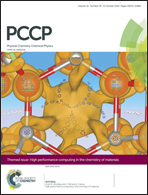A DFT study of the structures, stabilities and redox behaviour of the major surfaces of magnetite Fe3O4†
Abstract
The renewed interest in magnetite (Fe3O4) as a major phase in different types of catalysts has led us to study the oxidation–reduction behaviour of its most prominent surfaces. We have employed computer modelling techniques based on the density functional theory to calculate the geometries and surface free energies of a number of surfaces at different compositions, including the stoichiometric plane, and those with a deficiency or excess of oxygen atoms. The most stable surfaces are the (001) and (111), leading to a cubic Fe3O4 crystal morphology with truncated corners under equilibrium conditions. The scanning tunnelling microscopy images of the different terminations of the (001) and (111) stoichiometric surfaces were calculated and compared with previous reports. Under reducing conditions, the creation of oxygen vacancies in the surface leads to the formation of reduced Fe species in the surface in the vicinity of the vacant oxygen. The (001) surface is slightly more prone to reduction than the (111), due to the higher stabilisation upon relaxation of the atoms around the oxygen vacancy, but molecular oxygen adsorbs preferentially at the (111) surface. In both oxidized surfaces, the oxygen atoms are located on bridge positions between two surface iron atoms, from which they attract electron density. The oxidised state is thermodynamically favourable with respect to the stoichiometric surfaces under ambient conditions, although not under the conditions when bulk Fe3O4 is thermodynamically stable with respect to Fe2O3. This finding is important in the interpretation of the catalytic properties of Fe3O4 due to the presence of oxidised species under experimental conditions.

- This article is part of the themed collection: High performance computing in the chemistry of materials

 Please wait while we load your content...
Please wait while we load your content...